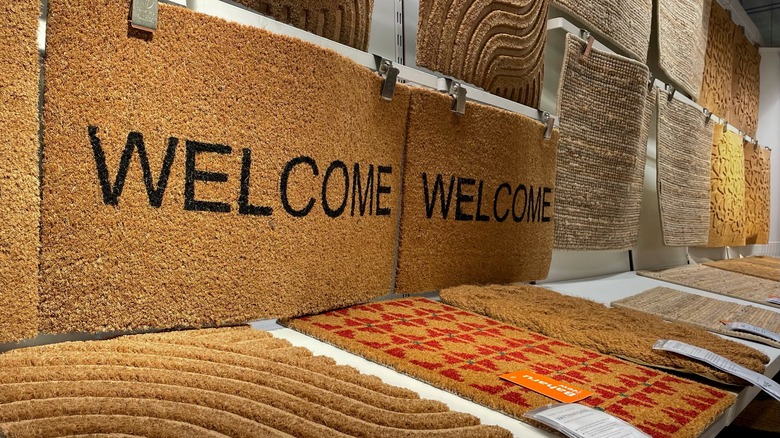How To Use Coir Mats To DIY An Affordable Backyard Path
We may receive a commission on purchases made from links.
You might not necessarily recognize the word "coir" (pronounced "COY-er"), but you probably know it on sight. It's that brown, scratchy, perfect-for-a-doormat material made from the inner fiber lining of a coconut shell. You might have one on your doorstep right now beckoning guests to come on in if they brought wine or follow the dog's house rules or maybe emblazoned with a simple, "Welcome!" That strong, fibrous material can withstand a lot of foot traffic plus years of weather extremes as it rests on your threshold. Those qualities giving the coir doormat endurance at your entrance are the same qualities that'll make it a good choice to DIY an affordable backyard path. How you turn the mats into a walkway is almost as easy as tossing them on the ground. (Almost!)
Using coconut coir mats as your "stepping stones" might not be quite as simple as tossing them on the ground, but using the easy-to-find mats is one of the least complicated paths you can build. Lightweight yet sturdy, they won't strain your back the way it might if you were choosing some other path builder. For example, if you picked from among one of the eight creative ways to cover a muddy pathway on the side of your home, you could find yourself hauling anything from log slices to rolls of artificial turf to stone pavers. Other paths are straightforward like coir, like the quick and simple wooden pathway that's easy to recreate in your backyard because it comes in a long roll that's ready to spread out and anchor. But if you want something softer to walk on, try coir mats.
Coir mats provide tidy, easy-care, walkable paths
The first steps in creating a do-it-yourself affordable backyard path from coir mats are to measure the length of your walkway and determine how many mats to buy. A typical doormat is 18 inches by 30 inches. Walmart sells them for about $7. Another option is to purchase the coir in a roll like the Yarrdfir Coco Liner Roll that's available on Amazon for about $39. At 24 inches by 160 inches (more than 13 feet), one or two are likely enough for most paths. It has a medium thickness but can be cut to size using sharp scissors.
After determining the layout of our path, the next step is to prep the site. Remove sod, weeds, and roots, then rake it. You can toss on a little sand to make the surface level. Help it last longer by adding a layer of landscaping fabric (secure it with U-shaped pins like Cewor landscape staples). Finish by topping it with sand, gravel, or mulch and add your coir mats or coir fiber roll. If you're using the roll, it may also need to be anchored by staples, but the mats will be thicker and shouldn't need to be weighed down.
When you're done creating your affordable DIY path, if you plan it just right, you might have enough coir left over to make an additional DIY feature to turn your backyard into a secret garden oasis. Just tuck some of the coir into an old chair bottom and turn it into a planter, making it a charming spot to enjoy along your affordable and easy new backyard path.
